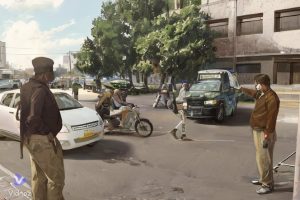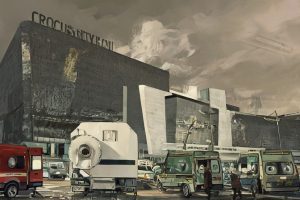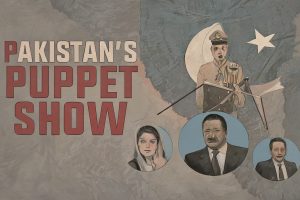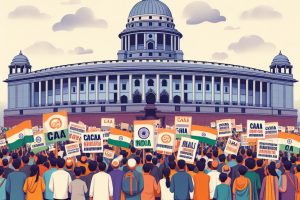Knowing the roots of the dispute
By Yasmeen Aftab Ali (USA)
A friend on Twitter posted on my timeline the following question: ‘Why 110km long border (Poonch Sector) in Kashmir is getting hot? Any idea?’ The amazing lack of being in touch with one’s roots never fails to horrify me. How can one form an opinion without knowing the historical background? What is the present but a continuation of yesterday and the history of tomorrow?
It was the Rajas of Loran who ruled Poonch. Poonch, also known as the City of Sufi Saints, boasts of a well-known name of Hazrat Doda Pir whose Urs attracts thousands. In 1848, however, Poonch was made part of the parcel transferred to Maharaja Gulab Singh under the Treaty of Amritsar. Prior to this handing over, it was a part of the Lahore district. Poonch suffered from repressive Dogra rule of the Hindu Maharajas, in particular the Muslims of the area. Poonch is bound by Line of Control on three sides. In 1947 it was split in two, one part each going to India and Pakistan. Currently, the Poonch district in India is divided into four tehsils i.e., Surankote, Mendhar, Haveli and Mandi.
Christopher Snedden, an Australian politico-strategic analyst, author, and academic specialising in South Asia, in his very interesting book ‘Kashmir: The Unwritten History’states, “The Poonch uprising has been ‘glossed over in virtually all accounts of the origins of the Kashmir dispute’. This serious and significant anti-Maharaja uprising by Muslims living in Poonch was a response to a number of factors. These included their dislike of the Hindu Maharaja and his repressive regime, their need to obtain protection from some anti-Muslim activities that the Maharaja’s army engaged in soon after Partition, and their desire for J&K to join Pakistan. Additional factors included the provocative stationing of Dogra forces in Poonch in 1947, the ‘invasion of Jammu by Sikhs’ and other militant non-Muslims after partition, and disenchantment with the corruption surrounding an unpaid per capita grant for personnel who had served in the Indian Army or the Labour Corps during World War II (while they were barred from serving in the Maharaja’s army).
A further factor concerned the Poonchis’ weakening ability to defend themselves. Hari Singh was aware that many more Poonchis and Mirpuris had military capabilities and experience than the numbers serving in his army. He also had been ‘specially impressed and alarmed’ by a gathering of some 40,000 men, ‘almost all ex-servicemen of the British Army from Sudhnutti and Bagh Tehsils of Poonch, assembled to greet him on April 21, 1947, at Rawalakot during his tour of the ‘frontier areas’ of J&K. In July 1947, the ‘spooked’ Maharaja’s government ‘encouraged’ military-capable Poonchis and Mirpuris to disarm, including those ‘on leave with arms and ammunition’ from the Pakistan Army. These Muslims then became ‘alarmed’ when the J&K Police, with whom they had deposited their arms, redistributed these to Sikhs and Hindus for self-defence.
A further factor motivating Poonchis was the creation of Pakistan and the Maharaja’s reaction to their support for it. The transfer of British power to the new dominions of India and Pakistan, coupled with Hari Singh’s vacillation on the accession, inspired much interest, even fervour, among the people of J&K. In Poonch, many people were already identifying themselves with Pakistan. From 14 August, the day before Pakistan became a legal entity and a physical reality, pro-Pakistan, anti-Maharaja meetings took place in Poonch, even though public meetings were banned. Many Poonchis declared their desire for J&K to join Pakistan, particularly on ‘Pakistan Day’ (14 August, 1947) when they raised Pakistan flags and supported the Muslim Conference’s (by now unequivocal) pro-Pakistan stance.”
Accusations by India that the Poonch uprising was supported by Pakistan were incorrect and false as pointed out by Snedden, “Geography also suggests that the Poonch uprising was an indigenous affair. The region that Poonchis inhabited was a remote, highland area, difficult to access. The jagir was east of the border created by the Jhelum River, which, flowing southwards from a point west of Muzaffarabad to near Mirpur town, physically separated Pakistan and J&K. Poonch was much higher and more difficult to enter than the undulating Mirpur lowlands at the end of the Punjab plains. After crossing of the Jhelum at Kohala, ‘the mountains of Poonch rise very steeply’. Furthermore, a person seeking to enter Poonch surreptitiously needed to secure transport to cross the swift-flowing Jhelum and avoid Kohala bridge, which the Maharaja’s armed forces guarded. These forces made the task even more difficult when they ‘cut off Poonch from direct communication with Pakistan’ by destroying the six ferries that facilitated Jhelum crossings.”
Hari Singh was indecisive and could not decide between aligning with either India or Pakistan. Therefore, he decided to maintain a temporary status quo signing an agreement with Pakistan to maintain different services including the transport service. Vernon Herwitt in “Kashmir, the Unanswered Question” is of the view that Hari Singh wanted to create an independent state joining neither of the two.
In the meanwhile, Lord Mountbatten who at the time was serving as India’s Governor-General, in his infinite wisdom (or lack of it) decided that Kashmir must join Indiatemporarily for peace. It was determined a vote of deciding upon the long-term status would follow later. Hari Singh signed the Instrument of Accession soon after. By so doing, he effectively handed over control of defence and foreign policy to India. India took over the major part of the territory whereas Pakistan was left with a small northern area.
The question forming the core dispute is whether the Indian troops arrived first making Hari Singh’s signing of the Instrument an unavoidable action directed by force or signing of the Instrument was followed by coming of the Indian forces.
However, both views ignore the core issue which in my considered opinion is that the Instrument of Accession in either case was a temporary measure to be followed by a vote to determine its long term future.
Therefore, Pakistan’s demand that a referendum must be held is a valid demand. Will India acquiesce to the demand? Obviously not. Vernon Herwitt writes: “The Indian emphasis upon the Instrument of Accession was weakened almost immediately by their decision to hold a referendum to ratify the decision of the Maharaja. The decision is revealing in the sense that both Nehru and apparently Mountbatten felt that ‘in the case of any state where the Instrument of Accession has been the subject of dispute [sic], the question of accession should be decided in accordance with the wishes of the people’. In his reply to Hari Singh’s letter asking for military help from India, Mountbatten noted that ‘It is my government’s wish that as soon as law and order have been restored in Kashmir, the question of the state’s accession was itself the subject of a dispute, and that some form of election was needed to further — and perhaps critically — legitimise the instrument of Accession. Following India’s referral of the case to the United Nations, the UN-sponsored ceasefire of 1949 and the establishment of a ceasefire line, India and Pakistan sat down to discuss the terms of the proposed referendum. However, the necessary conditions to ensure a free and fair result were never agreed.”
An interesting article by Dr Shabbir Chaudhry talks at length of Hari Singh’s priceless treasures, calculated in 2011 at Rs100 crore. “The treasure was reported to be in the custody of the Srinagar administration till 1981 in six huge steel boxes under the direct control of the then treasurer Dewan Iqbal Nath.” (May 11, 2011) According to Dr Chaudhry, ‘In 1963, two boxes — box number 3 and 5 — containing nearly 717kg of gold (worth today Rs60 crore) were “donated” from the treasure for the Defence Fund started by the Government of India to fight the Chinese.’
Chinese Author Li Peng rightly states, “As a historical legacy, the Kashmir conflict has been an outstanding issue for more than half a century.”
Seems like the conflict will continue for the years to come.







10 Comments
Comments are closed.